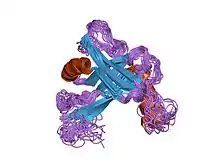| olfactory marker protein | |||||||
|---|---|---|---|---|---|---|---|
| Identifiers | |||||||
| Symbol | OMP | ||||||
| NCBI gene | 4975 | ||||||
| HGNC | 8136 | ||||||
| OMIM | 164340 | ||||||
| RefSeq | NM_006189 | ||||||
| UniProt | P47874 | ||||||
| Other data | |||||||
| Locus | Chr. 11 q14-q21 | ||||||
| |||||||
| Olfactory marker protein | |||||||||
|---|---|---|---|---|---|---|---|---|---|
 solution structure of olfactory marker protein from rat | |||||||||
| Identifiers | |||||||||
| Symbol | Olfactory_mark | ||||||||
| Pfam | PF06554 | ||||||||
| InterPro | IPR009103 | ||||||||
| SCOP2 | 1jyt / SCOPe / SUPFAM | ||||||||
| |||||||||
In molecular biology, olfactory marker protein is a protein involved in signal transduction. It is a highly expressed, cytoplasmic protein found in mature olfactory sensory receptor neurons of all vertebrates. OMP is a modulator of the olfactory signal transduction cascade. The crystal structure of OMP reveals a beta sandwich consisting of eight strands in two sheets with a jelly-roll topology.[1] Three highly conserved regions have been identified as possible protein–protein interaction sites in OMP, indicating a possible role for OMP in modulating such interactions, thereby acting as a molecular switch.[2]
External links
- Olfactory+marker+protein at the U.S. National Library of Medicine Medical Subject Headings (MeSH)
References
- ↑ Baldisseri DM, Margolis JW, Weber DJ, Koo JH, Margolis FL (June 2002). "Olfactory marker protein (OMP) exhibits a beta-clam fold in solution: implications for target peptide interaction and olfactory signal transduction". J. Mol. Biol. 319 (3): 823–37. doi:10.1016/S0022-2836(02)00282-6. PMID 12054873.
- ↑ Smith PC, Firestein S, Hunt JF (June 2002). "The crystal structure of the olfactory marker protein at 2.3 A resolution". J. Mol. Biol. 319 (3): 807–21. doi:10.1016/S0022-2836(02)00242-5. PMID 12054872.
This article is issued from Wikipedia. The text is licensed under Creative Commons - Attribution - Sharealike. Additional terms may apply for the media files.